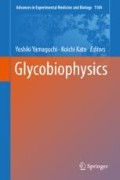Abstract
The capsid of Paramecium bursaria chlorella virus (PBCV-1) contains a heavily glycosylated major capsid protein, Vp54. The capsid protein contains four glycans, each N-linked to Asn. The glycan structures are unusual in many aspects: (1) they are attached by a β-glucose linkage, which is rare in nature; (2) they are highly branched and consist of 8–10 neutral monosaccharides; (3) all four glycoforms contain a dimethylated rhamnose as the capping residue of the main chain, a hyper-branched fucose residue and two rhamnose residues ''with opposite absolute configurations; (4) the four glycoforms differ by the nonstoichiometric presence of two monosaccharides, l-arabinose and d-mannose ; (5) the N-glycans from all of the chloroviruses have a strictly conserved core structure; and (6) these glycans do not resemble any structures previously reported in the three domains of life.
The structures of these N-glycoforms remained elusive for years because initial attempts to solve their structures used tools developed for eukaryotic-like systems, which we now know are not suitable for this noncanonical glycosylation pattern. This chapter summarizes the methods used to solve the chlorovirus complex glycan structures with the hope that these methodologies can be used by scientists facing similar problems.
Access this chapter
Tax calculation will be finalised at checkout
Purchases are for personal use only
References
Abergel C, Legendre M, Claverie JM (2015) The rapidly expanding universe of giant viruses: Mimivirus, Pandoravirus, Pithovirus and Mollivirus. FEMS Microbiol Rev 39:779–796
Biemann K (1992) Mass spectrometry of peptides and proteins. Annu Rev Biochem 61:977–1010
Bock K, Pedersen C (1983) Carbon-13 nuclear magnetic resonance spectroscopy of monosaccharides. Adv Carbohydr Chem Biochem 41:27–66
Cherrier MV, Kostyuchenko VA, Xiao C et al (2009) An icosahedral algal virus has a complex unique vertex decorated by a spike. PNAS 106:11085–11089
Colson P, De Lamballerie X, Yutin N et al (2013) “Megavirales”, a proposed new order for eukaryotic nucleocytoplasmic large DNA viruses. Arch Virol 158:2617–2521
De Castro C, Parrilli M, Holst O et al (2010) Microbe-associated molecular patterns in innate immunity: extraction and chemical analysis of gram-negative bacterial lipopolysaccharides. Methods Enzymol 480:89–115
De Castro C, Molinaro A, Piacente F et al (2013) Structure of N-linked oligosaccharides attached to chlorovirus PBCV-1 major capsid protein reveals unusual class of complex N-glycans. PNAS 110:13956–13960
De Castro C, Speciale I, Duncan G et al (2016) N-linked glycans of chloroviruses sharing a core architecture without precedent. Angew Chem Int Ed 55:654–658
De Castro C, Klose T, Speciale I et al (2018) Structure of the chlorovirus PBCV-1 major capsid glycoprotein determined by combining crystallographic and carbohydrate molecular modeling approaches. PNAS 115:E44–E52
Domon B, Costello CE (1988) A systematic nomenclature for carbohydrate fragmentations in FAB-MS/MS spectra of glycoconjugates. Glycoconj J 5:397–409
Dunigan DD, Cerny RL, Bauman AT et al (2012) Paramecium bursaria chlorella virus 1 proteome reveals novel architectural and regulatory features of a giant virus. J Virol 86:8821–8834
Gargiulo V, De Castro C, Lanzetta R et al (2008) Structural elucidation of the capsular polysaccharide isolated from Kaistella flava. Carbohydr Res 343:2401–2405
Jeanniard A, Dunigan DD, Gurnon JR et al (2013) Towards defining the chloroviruses: a genomic journey through a genus of large DNA viruses. BMC Genomics 14:158
Karakashian SJ, Karakashian MW (1965) Evolution and symbiosis in the genus Chlorella and related algae. Evolution 19:368–377
Legendre M, Bartolia J, Shmakov L et al (2014) Thirty-thousand-year-old distant relative of giant icosahedral DNA viruses with a pandoravirus morphology. PNAS 111:4274–4279
Lönngren J, Svensson S (1974) Mass spectrometry in structural analysis of natural carbohydrates. Adv Carbohydr Chem Biochem 29:41–106
Nandhagopal N, Simpson AA, Gurnon JR et al (2002) The structure and evolution of the major capsid protein of a large, lipid-containing DNA virus. PNAS 99:14758–14763
Ongay S, Boichenko A, Govorukhina N et al (2012) Glycopeptide enrichment and separation for protein glycosylation analysis. J Sep Sci 35:2341–2372
Philippe N, Legendre M, Doutre G et al (2013) Pandoraviruses: Amoeba viruses with genomes up to 2.5 Mb reaching that of parasitic eukaryotes. Science 341:281–286
Quispe CF, Esmael A, Sonderman O et al (2017) Characterization of a new chlorovirus type with permissive and non-permissive features on phylogenetically related algal strains. Virology 500:103–113
Raoult D, Audic S, Robert C et al (2004) A huge virus that infects amoebae contains genes that are not usually part of the viral repertoire and defines a family of ancient nucleocytoplasmic DNA viruses. Science 306:1344–1350
Speciale I, Agarkova I, Duncan GA et al (2017) Structure of the N-glycans from the chlorovirus NE-JV-1. Anton van Leeuw 110:1391–1399
Van Etten JL, Dunigan DD (2012) Chloroviruses: not your everyday plant virus. Trends Plant Sci 17:1–8
Van Etten JL, Meints RH, Kuczmarski D et al (1982) Viruses of symbiotic Chlorella-like algae isolated from Paramecium bursaria and Hydra viridis. PNAS 79:3867–3871
Van Etten JL, Gurnon JR, Yanai-Balser GM et al (2010) Chlorella viruses encode most, if not all, of the machinery to glycosylate their glycoproteins independent of the endoplasmic reticulum and Golgi. Biochim Biophys Acta 1800:152–159
Van Etten JL, Agarkova I, Dunigan DD et al (2017) Chloroviruses have a sweet tooth. Viruses 9:E88
Vigerust DJ, Shepherd VL (2007) Virus glycosylation: role in virulence and immune interactions. Trends Microbiol 15:211–218
Wuhrer M, Catalina MI, Deelder AM et al (2007) Glycoproteomics based on tandem mass spectrometry of glycopeptides. J Chromatogr B 849:115–128
Zhang X, Xiang Y, Dunigan DD, Klose T et al (2011) Three-dimensional structure and function of the Paramecium bursaria chlorella virus capsid. PNAS 108:14837–14842
Author information
Authors and Affiliations
Corresponding author
Editor information
Editors and Affiliations
Rights and permissions
Copyright information
© 2018 Springer Nature Singapore Pte Ltd.
About this chapter
Cite this chapter
De Castro, C. et al. (2018). Biophysical Approaches to Solve the Structures of the Complex Glycan Shield of Chloroviruses. In: Yamaguchi, Y., Kato, K. (eds) Glycobiophysics. Advances in Experimental Medicine and Biology, vol 1104. Springer, Singapore. https://doi.org/10.1007/978-981-13-2158-0_12
Download citation
DOI: https://doi.org/10.1007/978-981-13-2158-0_12
Published:
Publisher Name: Springer, Singapore
Print ISBN: 978-981-13-2157-3
Online ISBN: 978-981-13-2158-0
eBook Packages: Biomedical and Life SciencesBiomedical and Life Sciences (R0)

